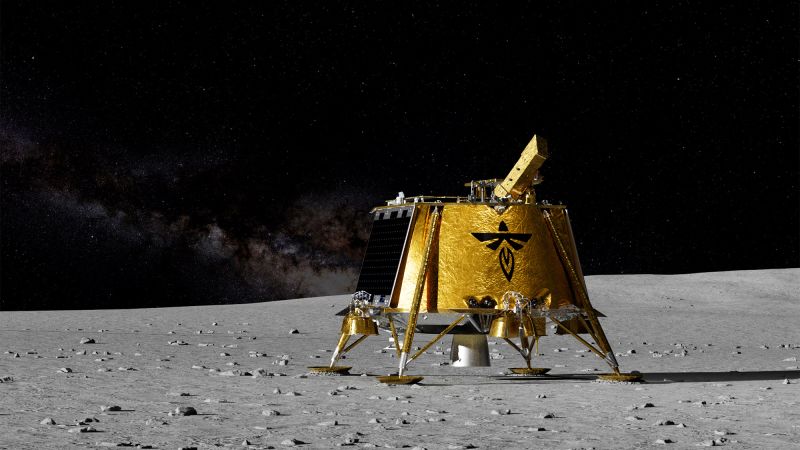**Explorations of the Lunar Race: Challenges and Ambitions**
The pursuit of lunar exploration has captivated human curiosity for decades. Landing on the moon is increasingly recognized as one of humanity’s most complex and formidable endeavors. This ongoing fascination drives both public entities and private enterprises to strive for lunar achievements. Even years before astronauts are poised to once again set foot on the moon, a cadre of robotic explorers is pushing the frontiers of what might be accomplished, representing the ambitions of various private companies.
Among the companies engaged in this lunar race is Intuitive Machines, which views the year 2025 as a pivotal moment for its lunar aspirations. After their Odysseus spacecraft experienced a less-than-ideal landing on the lunar surface in February 2024, it tipped over upon touchdown. With those lessons learned, the company is gearing up for another attempt, injecting a sense of anticipation for the upcoming achievements slated for that year, regardless of the outcomes from other lunar missions.
Recently, two remarkable lunar missions were launched aboard a SpaceX Falcon 9 rocket, each with distinct destinations and objectives as they journey toward the moon. The Blue Ghost mission by Texas-based Firefly Aerospace marks the company’s inaugural lunar lander. This mission aims to explore an ancient volcanic structure and will utilize its Lunar PlanetVac to collect soil samples for analysis. Contrastingly, Japan’s Ispace dispatched Resilience, which is an upgraded iteration of its previously developed Hakuto-R spacecraft. The Resilience mission intends to recover from its predecessor’s 2023 crash landing and carries a small rover and a unique red artwork titled “Moonhouse,” illustrating the multifaceted goals of lunar exploration.
The two missions indicate a broader trend in lunar exploration. Blue Ghost aims to land on March 2, while Resilience will take a more extended route to its destination, conserving energy for a journey expected to last four to five months. In the backdrop of these advancements, other companies are also making headlines, as demonstrated by Jeff Bezos’ Blue Origin. Recently, it successfully launched its New Glenn rocket into space, introducing a powerful contender in the race against SpaceX. This rocket carried a technology demonstration for Blue Ring, which is designed to pull satellites farther into space.
On the same day, SpaceX attempted a bold flight with its Starship spacecraft. While the company successfully recaptured the rocket booster upon reentry, the Starship itself experienced an explosion in mid-air, affecting air traffic policies over the Caribbean region. The Federal Aviation Administration is currently assessing the situation, pausing the Starship program while investigations into the debris and reported damages are underway.
Among other notable advancements in space exploration, India achieved an important milestone, successfully conducting an uncrewed docking between two small satellites, designated Target and Chaser. This remarkable feat positions India favorably as it aspires to develop its own space station and ultimately send an Indian astronaut to the lunar surface.
**Delving into the Depths of Marine Biology**
While the race to the moon permeates the headlines, remarkable stories also unfold beneath the ocean’s surface. British marine biologist Richard Smith is dedicated to unraveling the secrets of pygmy seahorses, some of the smallest vertebrates on Earth. His fascination with these colorful creatures stems from years of study that began in the early 2000s. Smith discovered that while many seahorse species are known for lifelong monogamous pairings, a particular species off the coast of Indonesia exhibits polygamous behaviors. He carefully observed a female he named Josephine, who captured the interest of three male suitors.
Fascinatingly, seahorses are unique in the animal kingdom as males carry and give birth to their offspring. Smith’s photographic documentation highlights the intimate and rare instances in the seahorse breeding process, including capturing the physical changes in male seahorses during gestation. His work culminates in a new book, providing a vivid glimpse into the vibrant life cycle of these diminutive creatures.
In a historical context, Royal Navy surgeon James Lind’s pivotal experiments in the 18th century unveiled the cure for scurvy, marking one of the first controlled clinical trials. Modern researchers now credit Francis Hauksbee the Younger, a lesser-known figure, for conceptualizing a similar testing methodology just years prior to Lind’s study, bridging the expansive timeline of medical discovery.
**Pioneering Efforts in Biotechnology**
Research into the past is mirrored by intriguing developments in biotechnology today. Companies like Colossal Biosciences venture into the eye-opening realm of de-extinction, aiming to recreate animals like the woolly mammoth, dodo, and Tasmanian tiger. This would utilize cutting-edge genetic and breeding technologies to simultaneously intrigue and challenge ethical norms. Although raised millions by prominent investors, leaders in this field acknowledge the complexity and potential ramifications of reviving extinct species, emphasizing that the process involves engineering new organisms rather than simply resurrecting the past.
In conclusion, the convergence of lunar exploration










